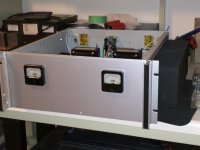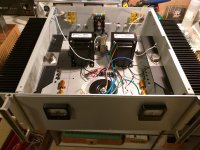did you find any strange sound before? great news SIT survived. once i set Vbias in opposite way, so it was biased with +4V 😀 i heard distorted music but i needed about 10sec to realize something was wrong on the circuit, but got no any smoke
it seems that SIT can absord human error, to give more courage on experiment.
I did not, but i had left the place for a moment and when i came back the amps had fallen to half, i.e. one channel did not draw any amps anymore.
After a first panic attack i measured drain to ground voltages and found that one channel did not conduct anymore. "Goodness it must have gone poof!"
Jost
Adjustable cathode bias
I'm wondering if the adjustable cathode bias like below is possible for for L'amp.
https://sites.google.com/site/yourtubeamp/mods-and-maintenance/bias/adjustable-cathode-bias
I'm wondering if the adjustable cathode bias like below is possible for for L'amp.
https://sites.google.com/site/yourtubeamp/mods-and-maintenance/bias/adjustable-cathode-bias
Is possible, but like some circuits like this, with source bias (appearing here and there in various posts), again is good to return the speaker ground directly to SIT source, to relax the source decoupling cap and exclude them from output current path.I'm wondering if the adjustable cathode bias like below is possible for for L'amp.
https://sites.google.com/site/yourtubeamp/mods-and-maintenance/bias/adjustable-cathode-bias
With proper component values will obtain smooth and more or less like PASS-SIT-1 range to tune output distortions. Some lab tweaking maybe will be needed.
Is possible, but like some circuits like this, with source bias (appearing here and there in various posts), again is good to return the speaker ground directly to SIT source, to relax the source decoupling cap and exclude them from output current path.
With proper component values will obtain smooth and more or less like PASS-SIT-1 range to tune output distortions. Some lab tweaking maybe will be needed.
Then I'll try to think what is the best way (value) doing it.
On LTSpice, it's just working as it should be and I have yet to see any obvious side effect with WE connection...
Side effect of the WE connection, I mean.
What I've found to work for a given pair of reasonably matched SITs is to use a 50 watt rheostat to dial in the best value for the source resistor then I order the 50 watters as needed to make that value. There is thermal drift on my rheostat though so I have to measure it "hot".
What I've found to work for a given pair of reasonably matched SITs is to use a 50 watt rheostat to dial in the best value for the source resistor then I order the 50 watters as needed to make that value. There is thermal drift on my rheostat though so I have to measure it "hot".
I meant to say side effect from "adjustable cathode bias" along with WE conection. The value of the additional resistor and pot are yet to determined, probably around 500ohm to 2k?
the bracket L in in direct contact with heatsink ??
or the side are in between
😛
They're direct connect with lots of compound in between.
I think I got reasonable values. For consistent input impedance and for usable control range, the choice is limited.The value of the additional resistor and pot are yet to determined, probably around 500ohm to 2k?
I will offer tomorrow seven 2SK180 with data at swap meet with data.
If anyone is interested you can PM me.
If anyone is interested you can PM me.
This would be a controversial subject, but I would like to hear how you guys choose output DC blocking capacitor.
It seems like even Mr. Pass is bypassing Electrolytic with film on his SIT amps, so I guess the choice of the capacitor would make some considerable difference in sound, but I don't know how to choose the right ones. Probably, computer grade ultra low ESR bypassed with huge fancy film would be ideal, but since I follow Mr. Pass's philosophy, I'm trying to avoid using "too-fancy" audiophile parts as much as possible. So I would like to know what numbers (ESR, voltage, film cap size, etc) should I concern.
It seems like even Mr. Pass is bypassing Electrolytic with film on his SIT amps, so I guess the choice of the capacitor would make some considerable difference in sound, but I don't know how to choose the right ones. Probably, computer grade ultra low ESR bypassed with huge fancy film would be ideal, but since I follow Mr. Pass's philosophy, I'm trying to avoid using "too-fancy" audiophile parts as much as possible. So I would like to know what numbers (ESR, voltage, film cap size, etc) should I concern.
Last edited:
use what Nelson is using
and just slab big honkin' motor run cap in parallel
say 30-50uF
this side of Big Splash , we have Icar and Ducati
on your side there is GE and ....... you probably know
I believe in info that substantial number of Audiofool grade caps are nothing else than beautified motor-run caps
and just slab big honkin' motor run cap in parallel
say 30-50uF
this side of Big Splash , we have Icar and Ducati
on your side there is GE and ....... you probably know
I believe in info that substantial number of Audiofool grade caps are nothing else than beautified motor-run caps
I am using motor run caps in my crossovers. Best sound yet. I have a couple of sets of crossovers one with PIO caps and right now I am preferring the one with motor run caps. I agree wholeheartedly Zen.
(I believe in info that substantial number of Audiofool grade caps are nothing else than beautified motor-run caps)
(I believe in info that substantial number of Audiofool grade caps are nothing else than beautified motor-run caps)
- Home
- Amplifiers
- Pass Labs
- L'Amp: A simple SIT Amp

